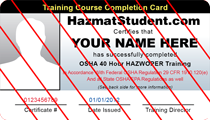Who Should Take This Course?
The OSHA 30 Hour Construction Online course provides training on the safety and health hazards associated with construction work environments. Workers with some level of safety responsibility, such as foremen or supervisors, will benefit from the more in-depth training provided in this 30 hour course (vs. our 10 Hour OSHA Construction online course, which is for workers without supervisory responsibility). The OSHA 30 Hour Construction course focuses on identification, control, avoidance, and prevention of hazards and injuries at construction sites.
This training is exclusively available to workers within the 50 U.S. states and certain territories governed by the Occupational Safety and Health (OSH) Act. Approximately 6-8 weeks after successful course completion, students within this jurisdiction will receive a Department of Labor (DOL) Wallet Card confirming course completion.






